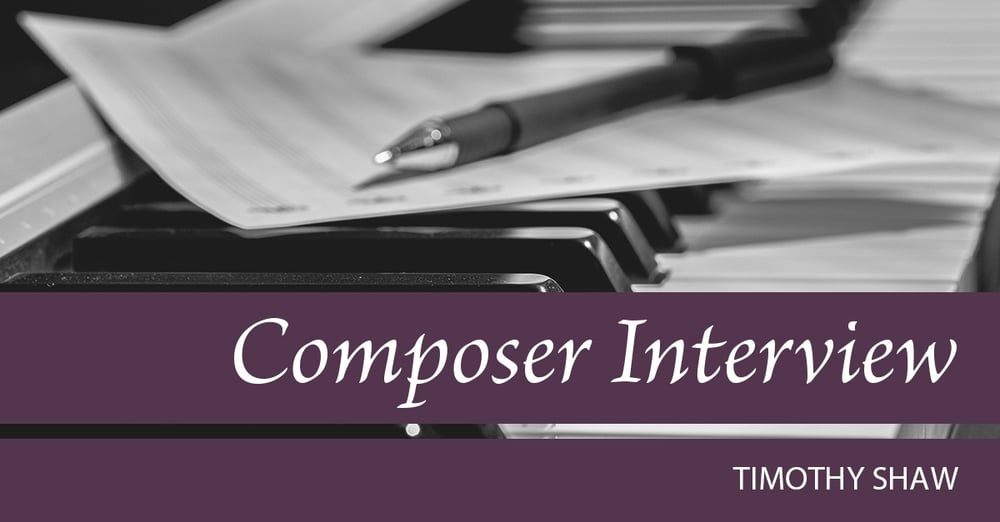Every artist knows that the details matter, and composer Timothy Shaw’s detail-oriented nature is probably one of the things that has made his music career so successful! Taking pleasure from things many other people may not notice, like a perfectly engraved musical score or a key change in one of his compositions, Timothy has composed more than a dozen pieces for CPH. Read our interview with Timothy and visit his author page on CPH.org to learn more about all of his compositions with us.
Tell us about your job outside of composing.
Like most musicians, I wear a lot of hats when it comes to music-making. In addition to composing, I do a good bit of music engraving for several publishing houses. I am a detail-oriented person, so I love the precision required to engrave a score accurately. I do not love the eye strain that comes from looking at a computer monitor all day, but I am learning to take more frequent breaks! I also teach private composition lessons and have begun doing so online. I meet with students virtually, using webinar software, and have found this to be a convenient way to teach people from all around the country. Currently, I am enjoying a much-needed respite from serving as a church musician, but I have more than twenty years’ experience as a choir director and organist.
When did you first start composing?
My first piano teacher was a gifted composer, and she encouraged me to put my musical ideas on paper. She directed a handbell choir at the small private school I attended in rural New Hampshire, and the first piece I ever wrote—when I was in seventh grade—was a piece for that ensemble. I did a little bit of writing throughout high school, mostly hymn arrangements for piano that I would play in church. I entered college as a piano major, but my theory professor, who was impressed by my part-writing assignments, urged me to consider studying composition instead. I continued to take piano lessons, but I changed majors and have been writing music ever since.
What sparked your interest in composing?
I caught the “composing bug” from a combination of two things: hearing great music performed by great musicians, and looking at composers’ scores and thinking “This is cool! This makes sense to me—it’s not as complicated as it sounds. I want to do this, too!” I have a vivid memory of turning pages for a pianist who was premiering a piano suite written by my composition professor. This was fascinating to me. I remember being struck by how powerful, how emotional, simple musical ideas can be when carefully shaped by composers and skillfully played by performers.
What is unique about composing versus other areas of musical focus?
The thing I love about composing, as opposed to performing or conducting, is the unlimited potential for creativity. To be honest, this is also one of the most terrifying aspects of composing; at times, the blank page can be rather overwhelming. I also enjoy the writing process itself, which, for me, at least, differs with every piece.
Sometimes I start by writing the melody; other times a chord progression is my way into a piece. Sometimes I start writing the beginning of a piece, but often I begin in the middle or even at the end! Composing also requires a lot of revising, which is hard work, and this is what I spend the majority of my time doing. Brahms, who is one of my favorite composers, summed this up nicely when he said, “It is not hard to compose, but what is fabulously hard is to leave the superfluous notes under the table.” When, after much labor, I achieve a musically refined, emotionally compelling piece of music, the feeling of satisfaction is immeasurable.
Could you tell us the story behind one or two of your favorite pieces?
One of my favorite pieces is an SAB anthem for Christmas, “We Praise You, Jesus, at Your Birth.” I wrote this when I was working with a small church choir that had only a few men, hence SAB! The fourteenth-century text, from German and Martin Luther, is stunning in its coupling of beautiful imagery with theological insight (e.g., “The gift from God’s eternal throne here clothed in our poor flesh and bone”), and the words captured my imagination the first time I read them.
I remember sitting at the piano with the text in front of me, improvising different musical ideas. The piano introduction came first, and the top notes of the right hand have a close affinity with the melody itself. This is one of the first pieces where I use chromatic-mediant harmonic relationships in depth, as the music shifts from D major to F major and back again. The return to D major on the word “alleluia,” which happens twice (measures 46–47 and measures 70–71), is one of my favorite passages in all of my music. Choir directors can make this moment particularly beautiful by observing the ritard, demanding pure vowels (“oo” and “ah”), and indicating a decrescendo.
To learn more about Timothy Shaw’s music and to see all of his compositions with CPH, visit his author page on CPH.org.














.jpg?width=50&height=50&name=IMG_20220621_160541_456%20(1).jpg)
